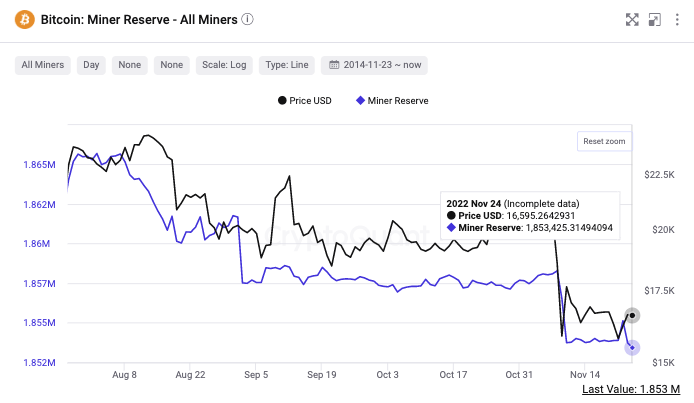Bankruptcies and falling profits spell doom for crypto mining industry

Recently exacerbated by the collapse of the crypto trading platform FTX, the ongoing crisis in the cryptocurrency industry has sent most of its participants into chaos, and it hasn’t spared Bitcoin (BTC) mining companies either, which are also pressured by other factors.
Indeed, bearish and sideways trading of nearly all crypto assets since January, paired with rising electricity costs, has started a domino effect of mining companies facing a profitability crisis or downright filing for bankruptcy, including several well-known names in the sector.
Compute North
The first domino to fall was Compute North, the second-largest Bitcoin mining hosting provider in the United States, which filed for Chapter 11 bankruptcy in late September, followed by another court order requesting a bankruptcy sale to liquidate assets to cover its accumulated debt.
Toward fulfilling the obligations of up to $500 million, Compute North sold two of its assets to crypto mining and staking firm Foundry for $14 million. At the same time, Crusoe Energy bought $1.55 million worth of assets. In early November, lender Generate Capital bought a stake in two of Compute North’s mining sites for $5 million.
Argo Blockchain
In October, Argo Blockchain informed the public that a combination of factors had affected its profitability, stating that “the price of both natural gas and electricity caused by the geopolitical situation in Europe and low levels of natural gas storage in the United States.”
“These factors, coupled with the decline in the price of Bitcoin since March 2022 and the increased mining difficulty, have reduced the Company’s profitability and free cash flow generation.
Argo’s press release from late October detailed its strategy to meet debt obligations and maximize liquidity, adding that “should Argo be unsuccessful in completing any further financing, Argo would become cash flow negative in the near term and would need to curtail or cease operations.”
Core Scientific
Another casualty of the crypto crisis was Core Scientific, which indicated in its quarterly report with the U.S. Securities and Exchange Commission (SEC) that it had accrued a net loss of $434.8 million over the third quarter of 2022, adding up to the $863 million it lost in the second quarter. Core Scientific also admitted it expected its existing cash resources to be “depleted by the end of 2022 or sooner.”
To add insult to injury, Core Scientific has also been slapped with a lawsuit alleging it had failed to disclose a series of financial problems in its statements to shareholders during 2022. The now-bankrupt crypto lender Celsius also accused the miner of refusing to meet its contract obligations.
Iris Energy
After failing to service a $108 million loan, Australian Bitcoin miner Iris Energy was forced to cut its BTC mining hardware it claimed was producing “insufficient cash flow” in a filing to the SEC on November 21. This has reduced its mining power by approximately 3.6 EH/s (exahashes per second).
In a strikingly similar situation to that of Core Scientific, the company is now facing the possibility of a class action in the U.S. over allegedly misleading its investors and misrepresenting its financial position in an initial public offering (IPO) from November 2021, during which it pooled $232 million in investments.
High energy costs meet falling crypto prices
Meanwhile, Bitcoin miner reserves have recently hit an 11-month low of 1,853,425 BTC, which suggests that BTC miners were capitulating, as noted by leading crypto trading expert Ali Martinez in his tweet on November 24.

As outlined by Argo Blockchain, it wasn’t just the poor climate in the general crypto market that affected the operations and liquidity of major mining companies. According to Bitfarms President Geoffrey Morphy, high energy costs have been another significant factor factoring in these miners’ demise.
In the view of Luxor Technologies’ head of content and Forbes senior contributor Colin Harper, the recent blow to Bitcoin’s price has further narrowed margins and deteriorated conditions for miners “in a year marred by crypto’s bear market and rising energy costs.”
As he added, this crisis “has the potential to drive companies that have survived thus far into bankruptcy,” the words echoed in the comments by the executive chairman of Hive Blockchain Technologies, Frank Holmes, who believes that “there are still many more bankruptcies” to come.
Disclaimer: The content on this site should not be considered investment advice. Investing is speculative. When investing, your capital is at risk.






 Bitcoin
Bitcoin  Ethereum
Ethereum  Tether
Tether  USDC
USDC  TRON
TRON  Dogecoin
Dogecoin  Cardano
Cardano  Bitcoin Cash
Bitcoin Cash  Chainlink
Chainlink  Monero
Monero  LEO Token
LEO Token  Stellar
Stellar  Zcash
Zcash  Litecoin
Litecoin  Hedera
Hedera  Dai
Dai  Cronos
Cronos  OKB
OKB  Tether Gold
Tether Gold  Ethereum Classic
Ethereum Classic  KuCoin
KuCoin  Gate
Gate  Algorand
Algorand  Cosmos Hub
Cosmos Hub  VeChain
VeChain  TrueUSD
TrueUSD  Dash
Dash  Tezos
Tezos  Stacks
Stacks  IOTA
IOTA  Basic Attention
Basic Attention  Theta Network
Theta Network  Decred
Decred  NEO
NEO  Synthetix
Synthetix  Qtum
Qtum  Ravencoin
Ravencoin  0x Protocol
0x Protocol  DigiByte
DigiByte  Nano
Nano  Zilliqa
Zilliqa  Siacoin
Siacoin  Numeraire
Numeraire  Waves
Waves  BUSD
BUSD  Status
Status  Enjin Coin
Enjin Coin  Pax Dollar
Pax Dollar  Ontology
Ontology  Hive
Hive  Lisk
Lisk  Steem
Steem  Huobi
Huobi  NEM
NEM  OMG Network
OMG Network  Bitcoin Gold
Bitcoin Gold  Augur
Augur  HUSD
HUSD  Ren
Ren